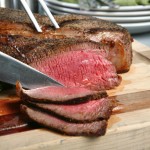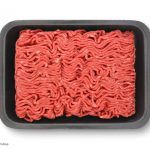Consumer Federation of America (CFA) is applauding the USDA's proposal to label mechanically tenderized meat. Beef that is pierced with needles or blades to break up fibers and make the meat more tender is a health risk because bacteria on the surface of the meat is forced into the interior. Then when the meat is cooked rare or medium, the bacteria in the meat is still alive and can make you sick. Christopher Waldrop, Director of the Food Policy Institute at CFA said, "this is good news for consumers. Without labeling, consumers would never know that the steak they are purchasing has been mechanically tenderized and may present a greater risk for foodborne illness." The process is used on less expensive cuts of meat. Because most people cook their steaks rare or medium, the danger … [Read more...]
Mechanically Tenderized Beef Should Be Labeled, Says USDA
Mechanically tenderized beef should be labeled so that consumers can prepare it safely, the U.S. Department of Agriculture's (USDA) Food Safety and Inspection Service (FSIS) said today. The agency is proposing new requirements for mechanically tenderized beef that would include labels with cooking instructions. Mechanical tenderization is a way to increase tenderness by piercing cuts of meat with needles or sharp blades to break up muscle fiber. During this process, bacteria on the exterior of the cut gets pushed to the interior. To kill the bacteria, cuts that are tenderized in this way must be cooked to a higher internal temperature, 160˚F, than those that are not, 145˚F. But right now, consumers don't have a way of knowing if the beef they buy has been mechanically tenderized or not … [Read more...]
Consumer Reports Studies Mechanically Tenderized Beef and Food Safety
In its June 2013 issue, Consumer Reports is tackling the issue of mechanically tenderized beef and E. coli illnesses. Food Poisoning Bulletin has told you about this issue before. Mechanically tenderized beef, which is a cut of beef that has been pierced with blades or needles to tenderize it, has been responsible for at least five E. coli O157:H7 outbreaks between 2003 and 2009. The problem is that while the interior of muscle cuts of beef do not usually contain bacteria, pathogenic bugs such as E. coli and Salmonella are on the surface. During slaughter, those bacteria from cow's intestines spread all over. The blades and needles easily push the bacteria into the center of the meat. Then, when a steak is cooked rare or medium rare, pathogenic bacteria are not killed in the center of … [Read more...]
OIG Audit Finds Beef Not Adequately Tested for E. coli
The Office of Inspector General of the USDA recently reviewed FSIS testing of boxed beef that is processed into ground beef or mechanically-tenderized steaks to see if the processes are adequate and used effectively to determine the sources of E. coli contamination. They found that FSIS needs to re-evaluate its methodology, since all boxed beef product is not adequately tested. Downstream processors grind boxed beef without sampling it for E. coli. In addition, grocery stores, butcher shops grind their own beef but FSIS does not sample and test trim at these facilities. E. coli 0157:H7, along with six STEC bacteria (Shiga toxin producing E. coli) are considered adulterants in raw beef. The report details twelve recommendations in response to five findings, including planning to modify … [Read more...]
E. coli Health Risk in Blade Tenderized Prime Rib
Whenever you order a steak in a restaurant, you are asked how you would like it cooked. I always order mine medium. But first I ask the server if the steak has been mechanically or blade tenderized. A new study in the March 2013 issue of Journal of Food Protection confirms what we have been reporting for some time now: that blade tenderized or mechanically tenderized steak presents a public health risk unless they are cooked well-done, or at least 160 degrees F. The blades or needles used in this process easily transfer bacteria from the surface of the steak all the way through it. Then when the steak is cooked less than well-done, you are eating live bacteria. That's not appetizing. And it's not safe. According to the study, boneless beef ribeye was inoculated on the surface with a … [Read more...]
E. Coli Outbreak at Longhorn Steakhouse in Cincinnati Prompts Questions
An outbreak of E. coli associated with the Longhorn Steakhouse in Cincinnati Ohio has prompted some questions about eating at restaurants. While the source of this outbreak was most likely leafy greens, E. coli outbreaks are usually associated with improperly handled or inadequately cooked meat. Whenever I'm at a restaurant, I always ask some questions before ordering. I ask if the steak has been mechanically tenderized, and I ask if they check the temperature of their burgers with a food thermometer before serving. There are good scientific reasons behind these questions. Foodsafety.gov has a chart of the safe minimum cooking temperatures for all foods likely to harbor pathogenic bacteria. Steaks that have been mechanically tenderized should be cooked to 160 degrees F, or well done. … [Read more...]
Health Canada to Review Safety of Mechanically Tenderized Meat
Health Canada has started reviewing the food safety of mechanically tenderized beef. Food Poisoning Bulletin has told you about this issue before. There is currently an E. coli 0157:H7 outbreak in Canada linked to mechanically tenderized steaks produced by the embattled XL Foods facility in Alberta. Mechanically tenderized beef has been pierced with needles or blades to break up the fibers in the meat. This automatically makes the meat more tender, but it can also bring bacteria from the surface of the meat into the interior. That piece of meat, cooked rare or medium, could be the perfect vehicle for deadly bacteria transmission. Normally, the interior of a solid cut of beef does not contain pathogenic bacteria, since it is solid muscle tissue. The review is studying the likelihood … [Read more...]
If Your Steak Had Some Work Done, Wouldn’t You Want To Know?
What it your steak had some work done? What if it went under the knife or the needle to become more tender? A steak that’s been mechanically tenderized, will still look like a steak and taste like a steak, but it needs to get cooked like a hamburger so it won’t make you sick. The problem is, you have no way of knowing if your steak was mechanically tenderized because that information isn’t required on food labels. But consumer advocates say it’s about time that it is. The Safe Food Coalition has been trying since 2009 to get the U.S. Department of Agriculture (USDA) to require labeling of mechanically tenderized beef products, which account for about 18 percent of beef cuts sold nationwide. This week, the group sent a letter to USDA Secretary Tom Vilsack urging him to take … [Read more...]






